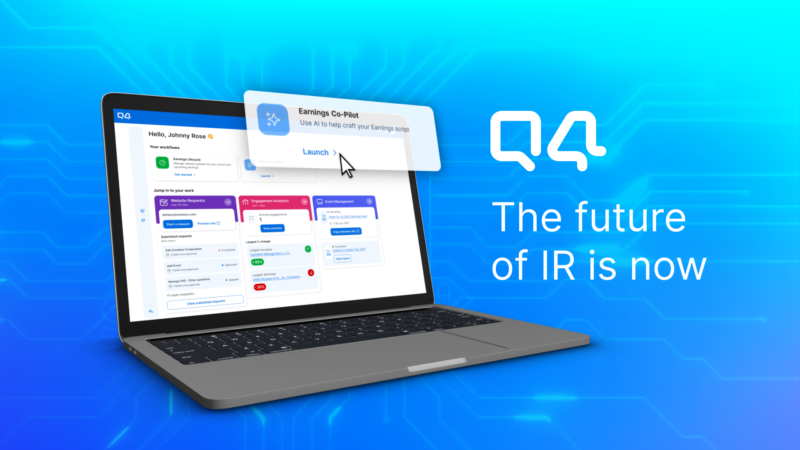Since Chat GPT’s launch in 2022, AI has been taking the world by storm. Despite the AI buzz and its promise for transforming every industry, integrating AI into IR isn’t a one-size-fits-all effort. Many IR teams may not be planning to use AI at all. Others however, have already started experimenting. To most IR teams and agencies, the question remains, “How do I get started with AI and what tools should I use?”
At Q4, we believe the future of IR is here with the AI-driven IR Ops Platform. We’re translating our deep IR expertise into simple, secure, and tailored AI experiences that are accessible from a single, powerful platform for investor relations.
Since many IR teams are thinking about how to leverage AI, here are a few ways you can get started with AI now.
Know AI’s strengths and weaknesses
Many IR leaders we speak with express excitement about AI, but struggle to understand the most effective applications. Generative AI has significantly broadened the scope of AI use cases, moving beyond applications like process automation and prediction.
Now, IROs and agencies can harness AI collaboratively to generate ideas for roadshows, plan conference agendas, create investor content, analyze and summarize peer data, provide feedback on their own materials, and help prepare for investor or board meetings. However, the array of available tools emphasizes the importance of defining the use cases you want AI to help you with. Knowing the specific applications you intend to explore ensures the use of the most suitable tool, ideally one built for the IR domain.
Many AI applications share the use of underlying models like GPT, so getting the most from this technology quickly requires considering how well the models have adapted for your specific use cases. Not all AI applications are created equal when it comes to usability, relevance and how they fit in your current workflow.
Identify use cases to focus on
Once you understand how this technology can help day to day, start thinking about where you can leverage it. Explore the tasks you and your team are currently responsible for. Categorize them based on how frequently they are done, how much effort they require, and how important they are to your leadership team. Doing this ensures you can prioritize where AI could fit in.
From our experience helping clients, we find writing earnings scripts and drawing insight from peer event transcripts frequently come up as being both high effort and high importance tasks for IR teams and agencies.
That’s why we’ve recently released one of the industry’s first, purpose-built AI Earnings Co-Pilot and peer event transcript summarization capabilities, directly accessible from the Q4 Platform.
Address risks and regulatory concerns
Given the volume of sensitive information IR teams deal with and the fact that only one third of organizations have an AI policy in place, you must ensure alignment with your legal, compliance, and security teams before getting started.
Most IROs we’ve spoken to about AI note concerns related to data privacy and security as the key factors holding them back. No IRO wants to unknowingly divulge material, non-public information to a third party provider that could be used to train models or made accessible before being reported.
Leading providers of AI tools will have safeguards around these risks, such as closed infrastructure that does not share data with the underlying model and will emphasize the highest data security standards. They will also give you options for where you should input this important financial data to maintain control.
Run a pilot and analyze results
With legal, compliance and security sign-off secured, you are ready to design an AI pilot. While there’s no use case too small to test, we recommend focusing on activities that require substantive effort to complete or tasks that are done frequently. Ensure you define your pilot goals, establish a timeframe , and align on success metrics.
For example, you could target reducing the time required to draft your next quarter’s earnings script by 50% or reducing the time spent educating your leadership team on the key takeaways from your peers’ earnings calls.
The goal of any pilot is to validate and test the benefits that can be derived from using AI as part of your IR activities. Throughout the pilot, assess whether factors like authenticity, tone, accuracy and relevance are maintained. The right AI tools for IR will have built their applications assuming a collaborative approach, requiring the review and judgment of a seasoned IR professional for any output.
Moving forward
Despite skepticism among IR teams regarding AI integration into their programs, numerous applications showcase the potential of blending their human expertise with AI-supported scale and intelligence. We don’t believe AI will replace the expertise of IR professionals, but adopting a systematic approach to testing the implementation of AI can enhance the effectiveness of internal IR functions and streamline time-consuming tasks for agencies. Integrating AI tools can immediately open capacity constraints and increase the creative space needed to address critical capital markets challenges.


